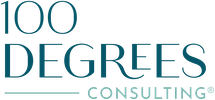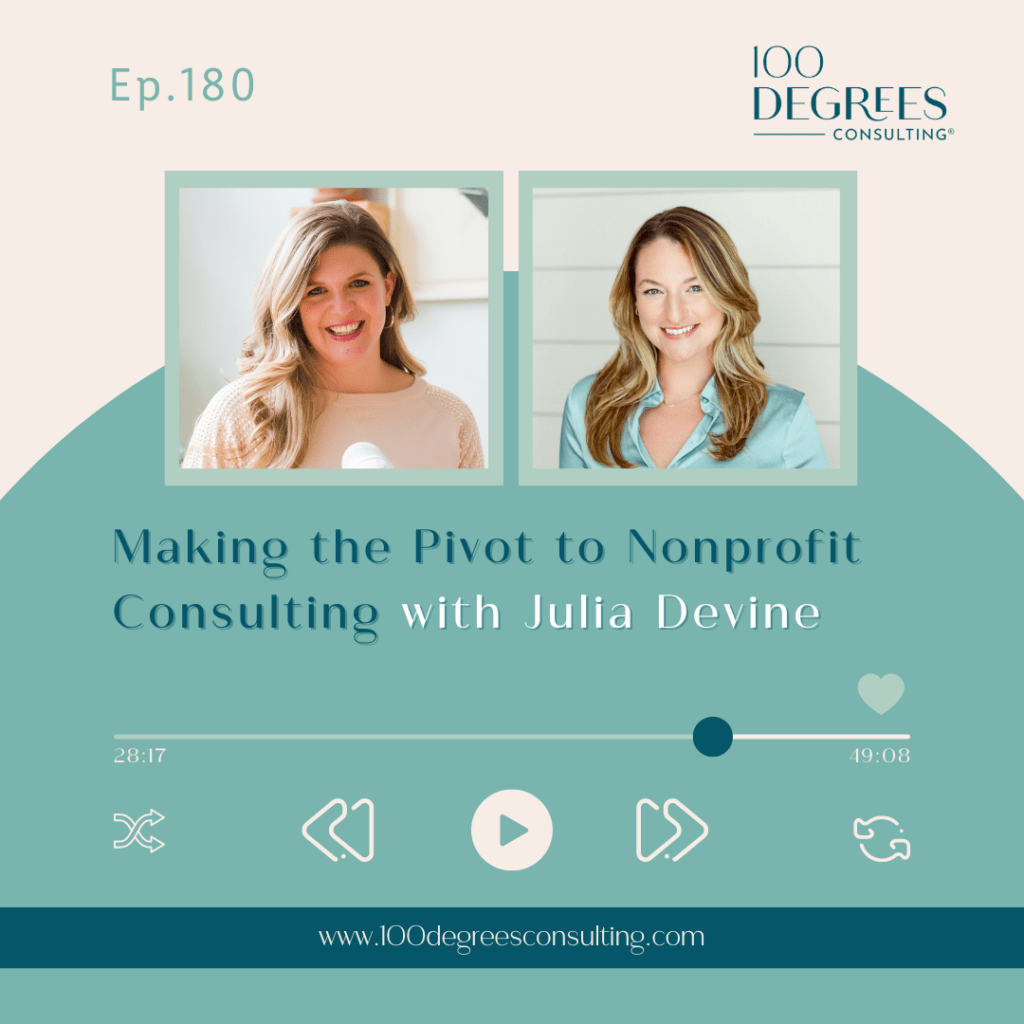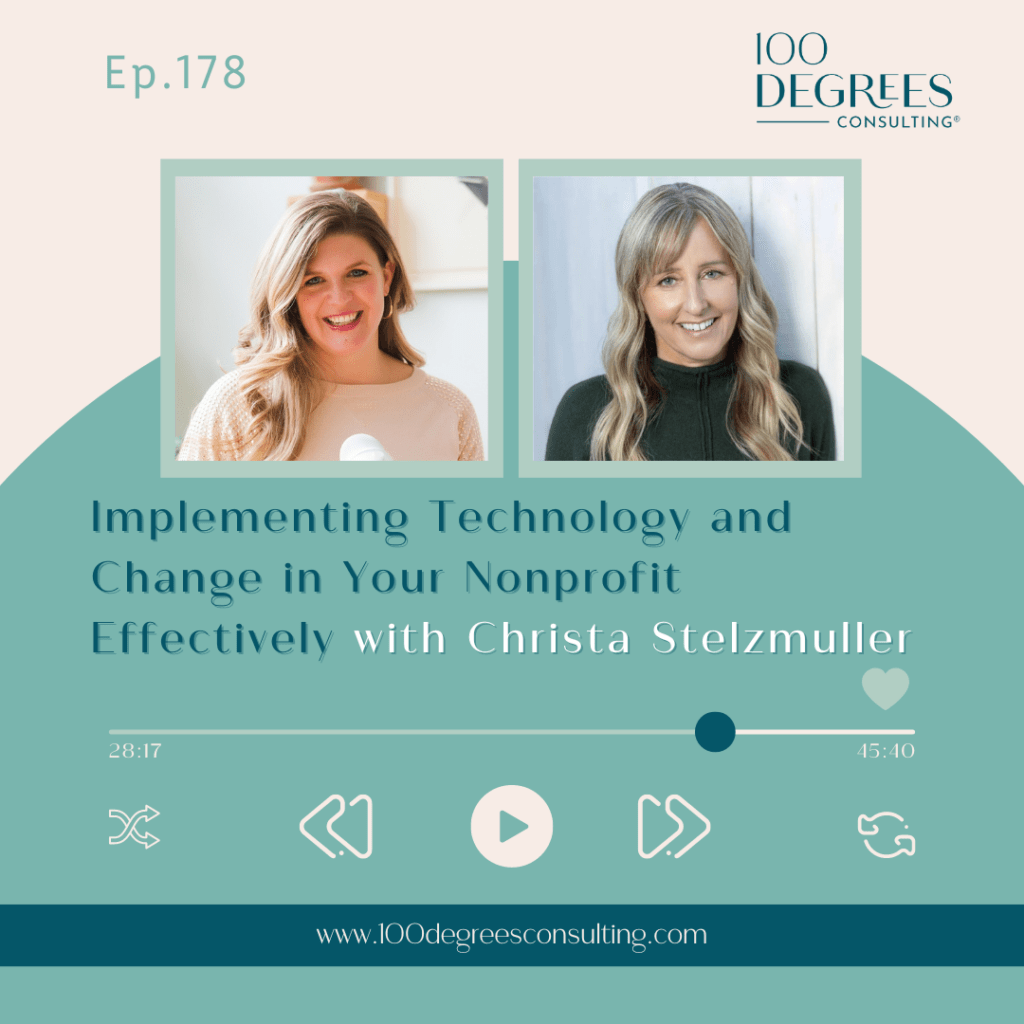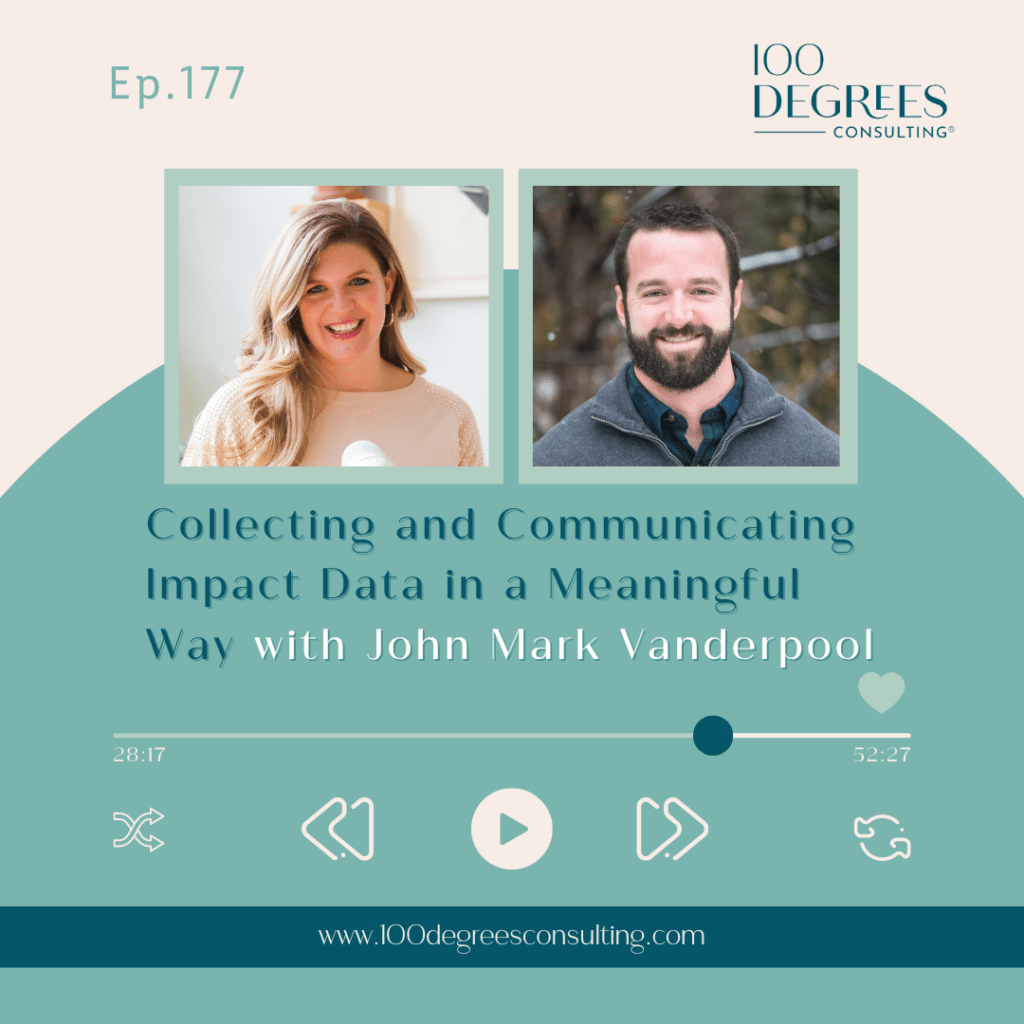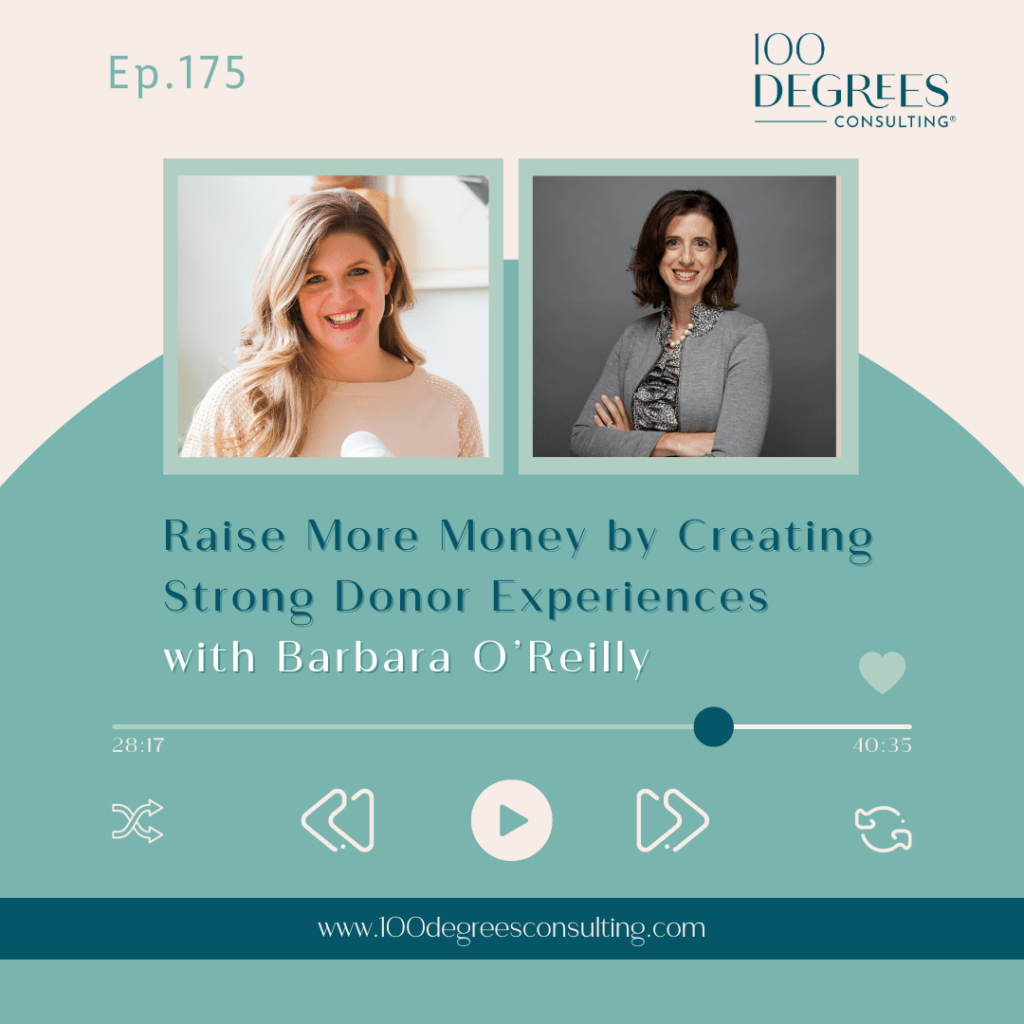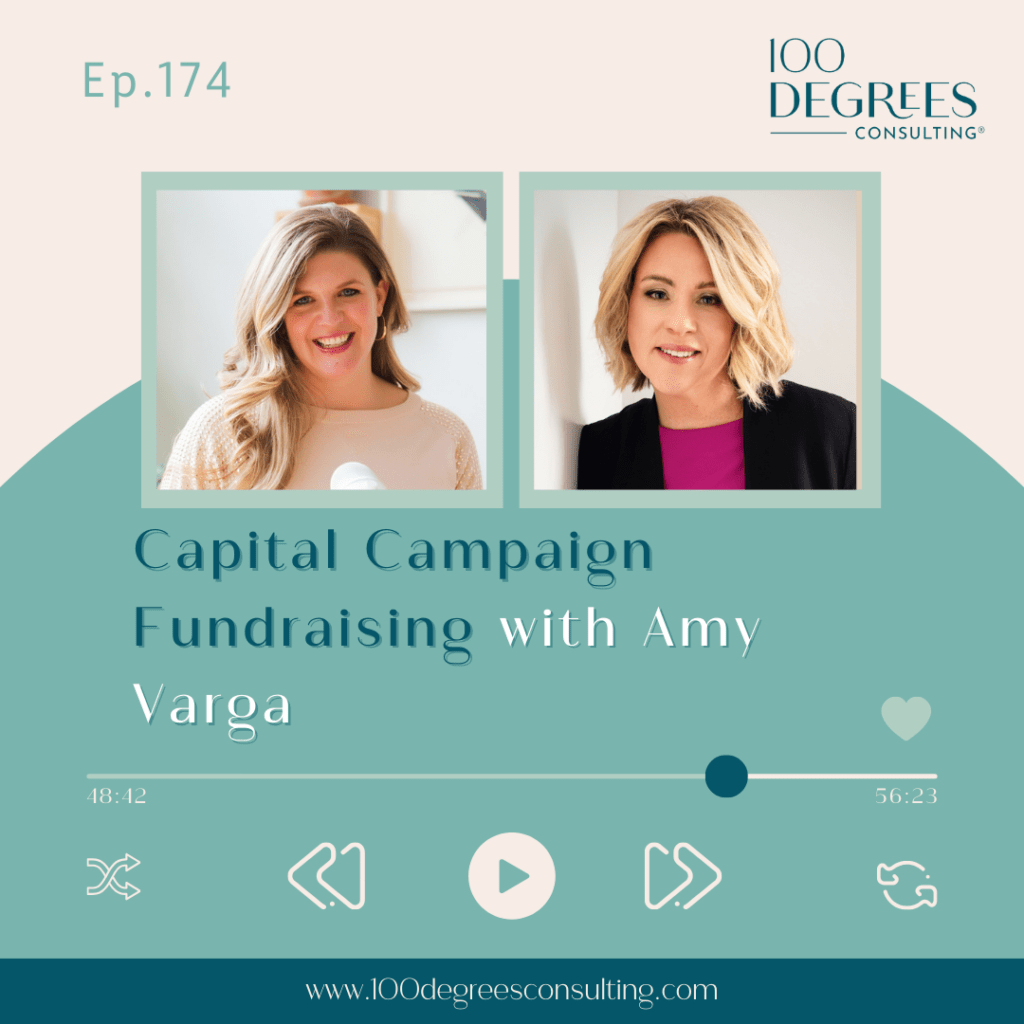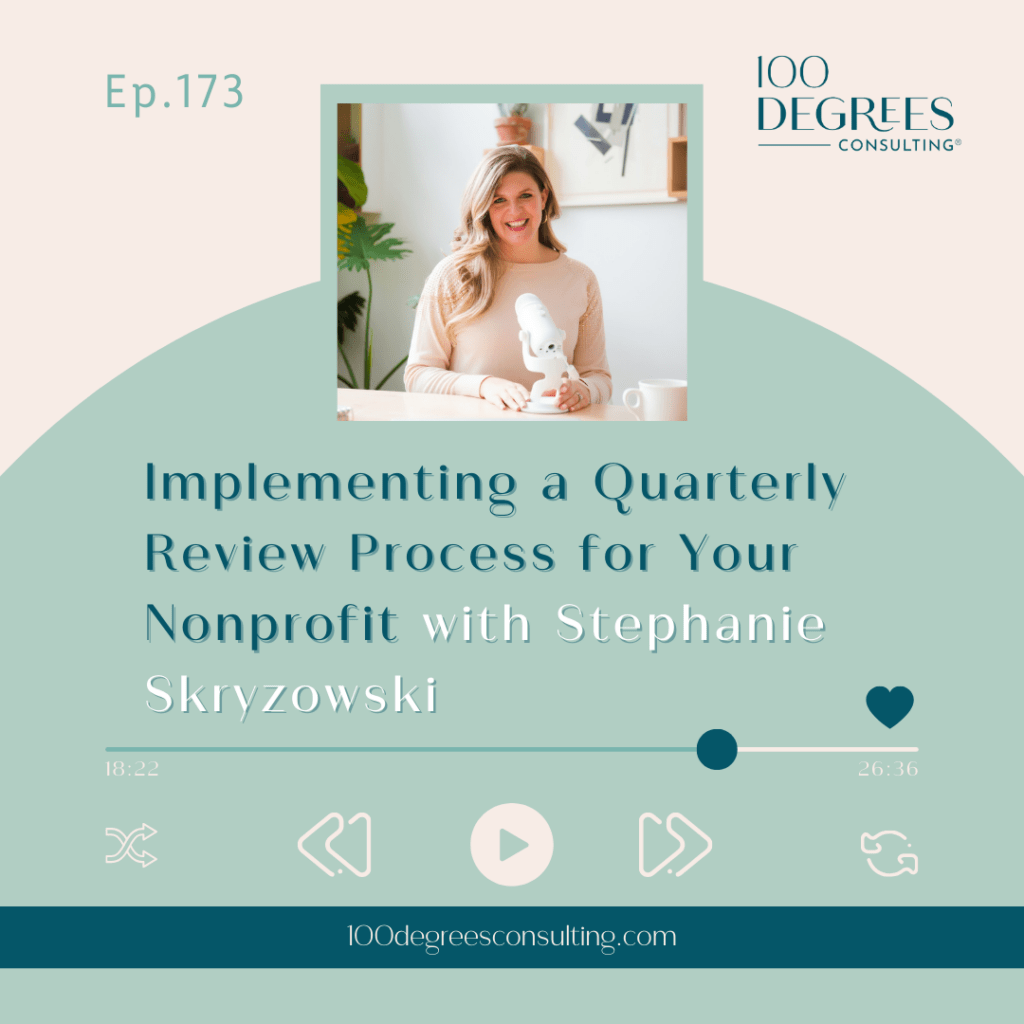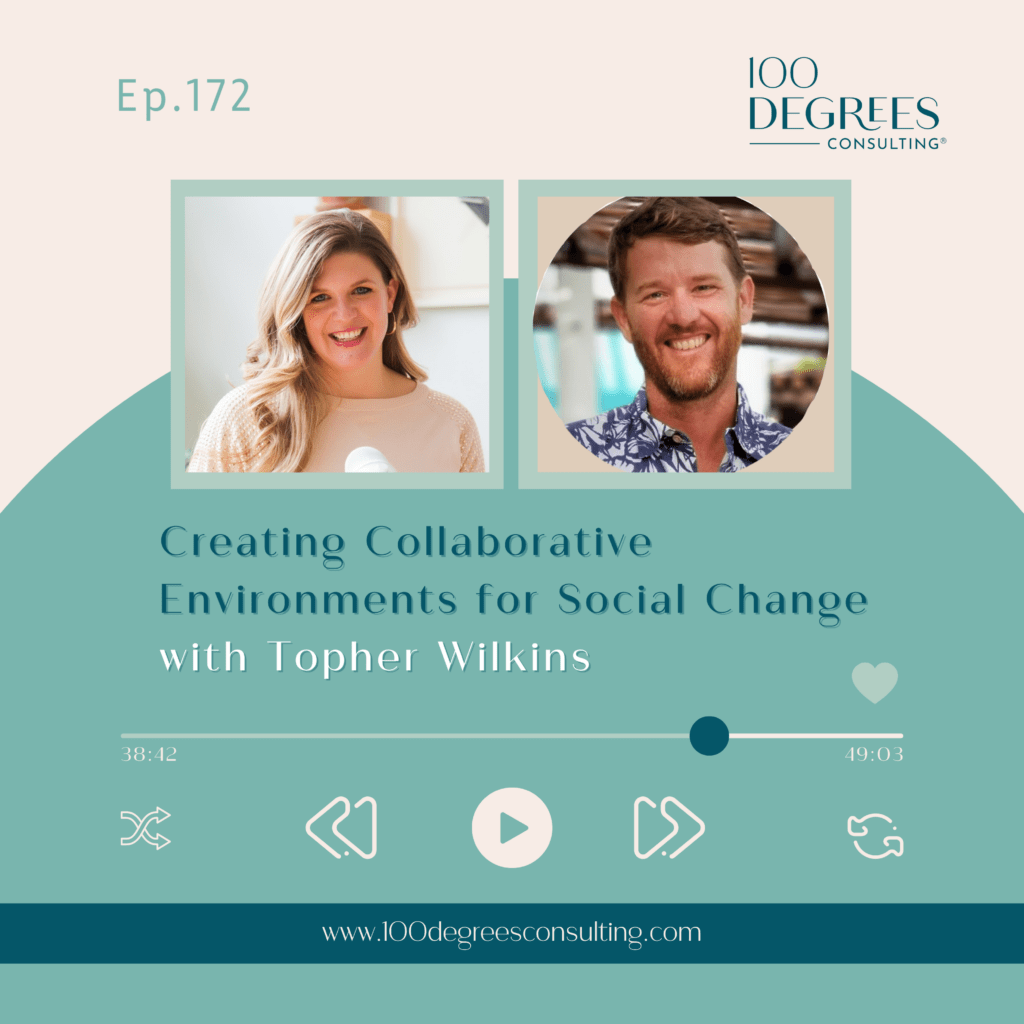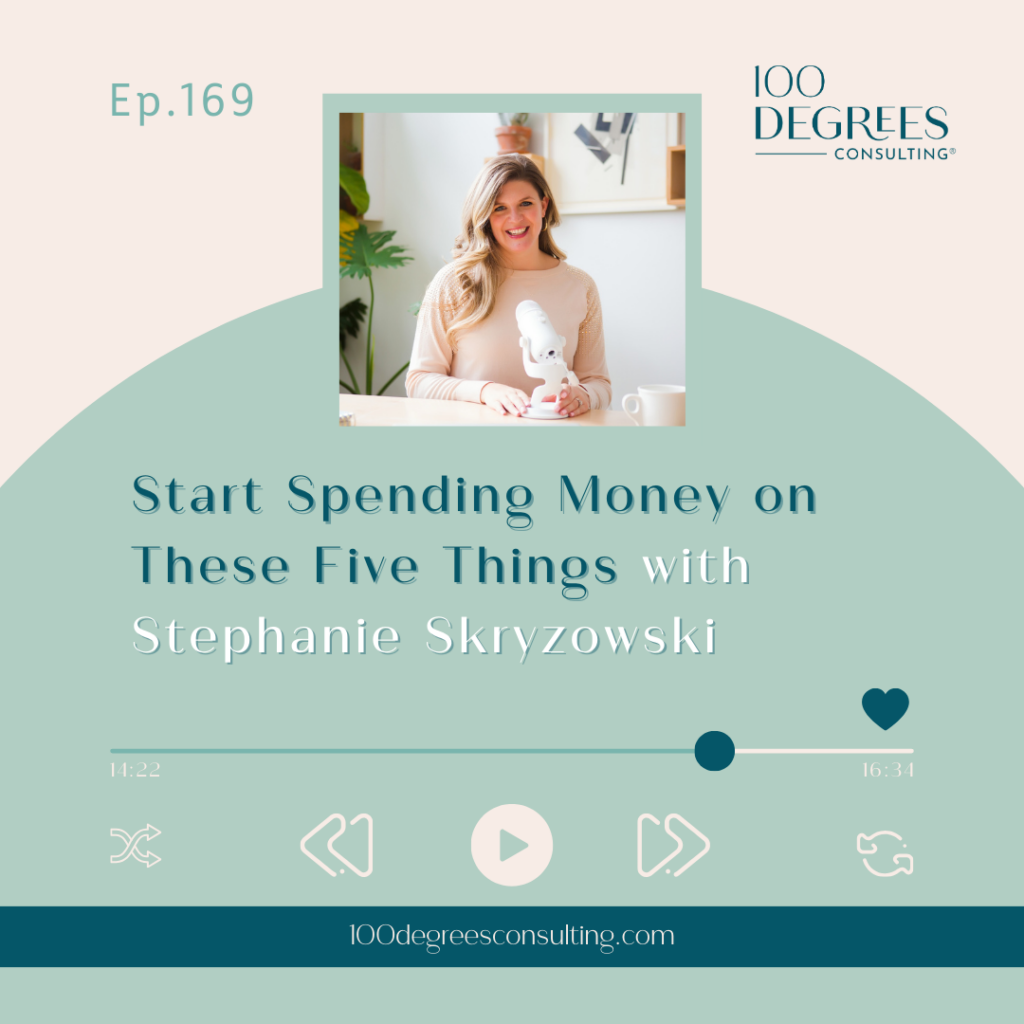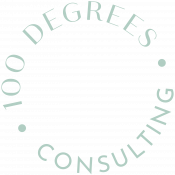Transcript Episode 136 – Finding Peer Connections as a Nonprofit Leader with Ellen Kehl on The Prosperous Nonprofit
Stephanie Skryzowski: [00:00:00] Welcome to the Prosperous Nonprofit, the podcast for leaders who are building financially sustainable and impactful nonprofits and changing the world. I’m Stephanie Skrzewski, a chief financial officer and founder and CEO of 100 Degrees Consulting. My personal mission is to empower leaders to better understand their numbers, to grow their impact and their income.
On this show, we talk to people who are leading the nonprofit sector in new. Innovative, disruptive and entrepreneurial ways, creating organizations that fuel their lives, their hearts, and their communities. Let’s dive in.
Hey everybody. Welcome back to the Prosperous nonprofit. I am here today with Ellen Kale, who’s the associate director with the Nonprofit Partnership, which is a capacity building and a resource group for nonprofit organizations in [00:01:00] Erie, Pennsylvania. So Ellen, And I chat all about what’s going on in the nonprofit sector right now and what are winning organizations doing to help them be successful.
And she listed out some really, really important qualities and characteristics of nonprofit leaders who are doing really well in quite frankly, what is kind of a challenging environment with different funding priorities and difficulty, you know. Recruiting and retaining staff and all of the things, right?
Well, she has a great perspective. Her organization has over 450 nonprofit member organizations. So she’s seen a lot and she has a great perspective. So I think you’re going to love this episode with Ellen. She’s going to share a little bit about her background and a little bit about the nonprofit partnership and what they do.
So I think you will. Love this episode and without further ado, let’s dive in and talk to Ellen.[00:02:00]
Hey everybody, welcome back to the Prosperous Nonprofit. I’m really excited to have Ellen Kael on the show with me today. Ellen, welcome. Yay. Thanks for having me. So we have known each other for a couple of years right now and collaborated with your work at the nonprofit partnership, but I would love to learn a little bit more about your journey and what you do now.
Sure. So I
Ellen Kehl: started as a social work student at the University of Pittsburgh, and I really, truly think that internships are the best teachers. Of course, experience is just the best way to learn. So I had had an internship that had both direct practice and kind of behind the scenes work at a non profit.
And I really felt attracted to the behind the scenes work and kind of just making things come to life, events, donations, all of those things. So I decided that That was the route that I wanted to go. So after being in Pittsburgh and getting my [00:03:00] little taste of a city, I was like, wow, I want nothing to do with that.
Um, time to go home and where I can drive from point A to point B in 15 minutes and be with my family. So. Back to the Erie community, I came and I got my master’s degree from Gannon and I got an internship with the non profit partnership while getting my master’s degree at Gannon University. Um, and it was kind of funny because I remember looking at the non profit partnerships website when I was in Pittsburgh thinking, Wow, wouldn’t it be cool to work there?
Like they get to help all the nonprofits, they’re doing all these cool trainings. I bet I could never get there. It’s such a small staff. How would I get in? So then when I saw the internship pop up a few years later or so, I was like, Ooh, this is meant to be, I might as well try. I got in and I’ve been here ever since.
So we’re going on nine years this winter. So it’s been like quite the. Um, I went from intern to a membership [00:04:00] manager to a membership education, something, something, other director that I made up like a title that was way too long. And now I am the associate director. So the running joke is I’m just waiting to kick my executive director out.
Uh, I say this in his face, so no one needs to send this to him. Um, but yeah, so now I’m just. really continuing to enjoy my work and it’s always changing. So it’s been a great ride so far and I’m happy to keep going on it.
Stephanie Skryzowski: That’s awesome. I feel like that feels kind of rare these days for somebody to stay with an organization for, especially like in our, um, I don’t know how old you are, but I’m like sort of grouping us together in the same generation.
Um, and our generation to be there for almost a decade. That’s, that’s incredible. So you’ve seen, you’ve seen a lot of changes in the sector. Tell us a little bit more. Um, I want to talk about that for sure, but tell us a little bit more about the nonprofit partnership itself. What do you do? What is [00:05:00] your mission?
Ellen Kehl: Sure, so our mission in a nutshell, which is funny because we have a nut in our, um, branding, but anyways, um, in a nutshell is to pretty much train, celebrate, educate, celebrate, and connect the nonprofits, right? Like that’s a very condensed version of it. But it comes to fruition through different capacity building trainings, which again is just a fancy word for we provide workshops and stuff on the things that the nonprofits need.
So there’s that aspect to it. There’s the connections, which is actually probably my favorite part, um, bringing the nonprofits together with each other or partners that can support them. funders, whoever it may be, to get that mission moving forward. And then the celebration aspect, another one of my favorite parts, so maybe I just kind of like it all, um, is our Celebrate Nonprofits Week.
We do a lot of different activities for the nonprofits through that, um, in June. You can learn more at celebratenonprofits. org if [00:06:00] interested. It’s funny because we looked around, like, this has to already exist, and it doesn’t. So we brought that onto our kind of menu of things within the last four years.
We have our non profit excellence awards. We do just a lot of like member spotlights. We have over 450 members, so it’s really easy to find someone doing something really cool and to point towards them and say, wow, look at this. So it’s really fun to. bring the literally the spotlight on them since we have a platform to do so, right?
So that’s a really small version of what we do, but we exist for our members and we continually change to provide whatever it is they may need. If we don’t have the answer, we’ll find it. I like to think we’re the Google for nonprofits. Um, so come our way and we will hunt it down and we will find someone to give an answer.
Stephanie Skryzowski: Oh, that’s awesome. And I think that’s so [00:07:00] needed in the sector is this like hub of resources that we can turn to. So 450 members and you’ve been doing this for almost a decade. What are some of the needs and challenges that you’re seeing from nonprofit organizations right now? So the needs
Ellen Kehl: and challenges, I mean, they’re always kind of Ebbing and flowing, right?
Currently, I would definitely say time management, staffing, a lot of kind of the after effects and ripples from COVID. I think everyone’s feeling that. Funding is always a thing. That one remains constant. So if it’s staff capacity to get the funds in, um, to diversify funding streams, whatever it may be, if We try to provide maybe contacts or direction on how to address those things, but it’s definitely difficult.
The, the issues continue to become more complex, and it’s not something [00:08:00] that a training can fix most of the time. So we definitely have to look at things in a broader scope and learn how to attack them. At a lot of different directions,
Stephanie Skryzowski: totally, totally. I definitely agree with all of that. I know the staffing piece is something I’ve had a lot of conversations about recently.
So today I like to batch my podcast episode. So this is number three of the day and in both of the two right prior to this, we were talking about staffing in a big way and salaries and that discrepancy between what organizations can pay and what, you know, what. Staff what employees really need and the need for unrestricted funding and all of the things.
So it’s interesting that you mentioned that as well. And are your members largely in the Erie, Pennsylvania? Like Northwest PA area or do you go geographically broader than that? So they are
Ellen Kehl: mostly [00:09:00] in the Northwest Pennsylvania area, but we are not limited to that area So if someone comes to me wanting to become a member from Georgia or wherever it may be You’re absolutely welcome.
Um, I just like to make sure people know that there are some programs that are in person only just to get that kind of in person only connection with each other, right? So I always make sure that they’re aware of that because I don’t like to take money from nonprofits for fun. Um, and it’s already a nominal membership fee, but still it feels super icky.
So I have that conversation first and we are going into strategic planning this year. So it might be that there are more opportunities for members outside of the area, but our focus is right now on the people that are closest to
Stephanie Skryzowski: us in the groups. Mm hmm. Yeah, that totally makes sense. Talk more about this.
You know, it sounds like one of your core values, whether you call it that or not, is this sense of connection. And why do you think that is so [00:10:00] important for nonprofit leaders? I think
Ellen Kehl: connection is so important because that is where I’ve seen the magic happen. So especially this year, we started a cohort for leaders, which doesn’t sound very new or innovative or whatever.
Um, but it’s new to them when we bring them together. And this is the first time they’ve been in the room with. leaders in the same playing field. Um, and it’s awesome to see them be like, wow, I didn’t know other people feel this way. Oh, I have this connection here. Do you want me to make an introduction?
Yeah, that would be awesome. So just seeing the excitement and kind of the invigoration it gives to this group of people. It’s just practice right in front of your eyes coming. I don’t even know how to say this properly, but literally the magic happening before your eyes. So throughout almost my nine years here, that has been the case every time we get people together.
And [00:11:00] I love bringing in Awesome experts in the field like you and getting you to teach the people, but you’ve probably even saw when we had our training in person, like getting the people to actually connect, just kind of ties things together on another level. Um, so yeah, it’s one of my favorite things.
Absolutely.
Stephanie Skryzowski: Yeah, it’s so interesting because as an entrepreneur, I’ve run my business now for almost eight years and before that I was. Like working in the nonprofit sector and since I’ve been running the business, I’ve always been part of like a, a mastermind, a group of, you know, 10 or 15 other people who are running similar businesses and we have each other to bounce ideas off of.
But I think about my time in the nonprofit sector and I felt like I was all by myself. I didn’t have anybody. I didn’t have any peers that I could go to. Yeah, there were other people that worked in my organization, but sometimes like you kind of need to talk about the organ, you know, you need to like talk about the challenges you’re having and like your boss is not necessarily [00:12:00] the person to do that.
So, or like if you’re the executive director, you know, it’s maybe not something that you need to go to your board about, but you could use some other like peer support. So I love that that’s something that you’re able to, to provide. Cause I just think it’s not. It’s not easy to find, um, like you can’t Google, like, non profit friends.
Where do I find non profit friends? So I think that is fantastic that you’re being so intentional about that. And do you sort of do things where there’s cohorts of groups that are together for a period of time? I’ve seen that be really effective because it’s like, yeah, on a one off workshop day, there’s only so much connection that you can really make there.
And it’s that, you know, spending time together over a period of time. That’s really, really helpful. Yes. So
Ellen Kehl: the new one for this year is over a period of eight months and it’s been really successful so far. Uh, we have one for leaders and fundraisers. But then there are options throughout the year too that you don’t need to come [00:13:00] all the time.
So we have like a fundraising focus group, midday marketing meetup, um, leadership forum as well. So there’s options. That’s one of our big things is we have so many different types of members. So making sure that they have a lot of things to pick from with their varying schedules and needs is super important.
Mm hmm.
Stephanie Skryzowski: Yeah, that’s really interesting. I’ve seen at least a lot of different changes in the nonprofit sector, like funders are having different funding priorities, different streams of funding are drying up because priorities have shifted. There’s lots of new and changing technology. There’s this whole idea of like a remote workforce, like all of these different changes and challenges in this sector.
How have you seen organizations really keep up with those changes, and what do those organizations do, like, what have you seen really work well for organizations that are keeping up and doing well? Oh, that’s a big one. So, I think
Ellen Kehl: that that kind of speaks [00:14:00] to one of your questions you sent me beforehand as to what a prosperous nonprofit looks like.
And I think that the way that these people, these groups are keeping up is through different things, like embracing technology. So I think that some of the older, when I started, I definitely noticed that there was a, this is the way we’ve always done it mindset, which I think could actually be. thought of as like a sickness because that is not good.
Um, we should not always do something because it’s the way we’ve always done it. So I’m seeing a lot of success in some of our non profit groups that do not subscribe to that feeling. They’re like, actually, there could probably be a way that we could better do this. And they’re researching those methods, making connections, talking with other groups that are doing X, Y, Z in technology or back office services or, um, governance, [00:15:00] training, whatever it may be, they’re taking those steps to move forward and implementing them.
So that was another thing I used to see in the beginning was a lot of planning and plans that would then sit in a binder on the bookshelf. So I definitely see. that less and less, which is wonderful. So plans being put into action and embracing things and moving forward, taking advantage of resources, all of those things which are coming out as prosperous nonprofits.
Stephanie Skryzowski: Yeah, I totally agree. And for organizations or maybe even leaders who are new to the sector, or they’ve just been kind of like, you know, operating in their tunnel for a long time. How does one find these resources? Because I feel like. You know, sometimes, Google’s like an endless hole sometimes. So how.
Right. Yes. Yeah. How does one go about finding these resources to [00:16:00] support them? I think that
Ellen Kehl: connecting with a local group
Stephanie Skryzowski: like ours is a great first step.
Ellen Kehl: So that is not to promote myself at all. I actually have recently been talking to a lot of groups like ours from all over the United States. States just to do some kind of research and see what they’re up to and how they’re doing.
So there are groups like us capacity building nonprofit groups all over the United States and probably further, but they’re doing amazing things and they have these hubs of resources in these communities that you can connect with. So I think that that’s step one is like ask for a meeting. Maybe.
Throughout learning about that organization and what the nonprofit landscape is, you will come across things that you didn’t know existed, um, opportunities you didn’t know that were available to you, communities that you could connect with, um, like your local AFP chapter as well, that’s also typically an Awesome community.
I [00:17:00] know ours is. So there’s a lot of communities. I think you’re right. Google is definitely an endless hole and that’s why I like to say we can be your Google so you don’t just get lost in the hole. So yes, connecting with your local group like ours I think is a good step.
Stephanie Skryzowski: Mm hmm. Yeah, I love that. And I’ve done some research for my own purposes, but there’s like, there’s a state association of nonprofits in every single state.
And then there are even more like resource groups like yours, like the nonprofit partnership. So I think that is a great place to start instead of trying to like, I don’t know, go big. Find the one organization that is the association or the sort of resource group around where you live. I think that’s a great tip and kind of start there.
So, okay, so what I’m seeing is a lot of organizations really needing to, I’m kind of shifting gears a little bit, needing to. Implement new technology, whether it’s, you know, a finance and accounting software, or whether it’s like a donor database [00:18:00] or something to track programmatic data and KPIs. And this can be like a really tricky sticking point for organizations because they don’t have the capacity or the expertise internally to like.
Make the decision on which one is the best and then actually implement it. Are you seeing this as a challenge for nonprofits and how are, if at all, how are you sort of helping nonprofits like get over this challenge? Cause we need the tech, but it’s like, it’s really hard to find the expertise to get us there.
Ellen Kehl: Yeah, so definitely, I think this is consistently a challenge, and I think one of the ways that we like to attack this, it’s like when you go to buy something online. I don’t know if you’re like me, but I instantly go to the reviews. I’m like, what do the people have to say? So it’s important for Yeah. us as a non profit partner, the non profit partnership to connect with some of these groups and get to the humans behind them and actually have [00:19:00] conversations with them and to pair that with our non profits that might use X service.
and actually hear from them if they enjoy it, then we can feel comfortable actually referring that service out. So that’s one kind of more intense way that we do it with some different partnerships. And I would also say that we suggest demos. Like, I think that no matter what service you’re looking for, a demo is always an opportunity.
So actually seeing the guts of a system, like, can I even manage this? I mean, I know when I looked at some of these different systems, when we were changing our membership management, I was like, wow, this isn’t even. Uh, for us at all. This is for like a chamber or something like that. So getting into the behind the scenes of the system is definitely a step in the right direction.
And if a group doesn’t have time for that, we’ve even done these demos for our non profits. And like, [00:20:00] actually, after I’ve looked at this, I can tell that this is not going to fit the needs that you outlined for me. So I think, again, that’s when one of your… Associations or whoever you may have in your area would come in handy like we’re here to support you Let us do some of the dirty work because it’s going to help us next time a member comes asking that question as well
Stephanie Skryzowski: yeah, I mean I didn’t even think about that as a potential resource, but I love that you’re kind of digging in and And figuring things out on behalf of your members so that you can provide really good referrals so that’s like another reason for our listeners who are non profit leaders to think about like Okay, how can we join a group like this?
Because it is, yeah, I mean, gosh, like think about the hour saved and this is not meant to be a pitch of like the nonprofit partnership or any nonprofit association, but like, I didn’t even think about that as a potential resource. So I’m so glad you shared that.
Do you feel like you’re missing something when it comes to your [00:21:00] nonprofit’s finances, but you have no clue what you might be missing? I’d venture to guess that one of the reasons you feel overwhelmed and nervous about your financials is because you don’t have a solid monthly routine. So I have created a free finance routine checklist for you.
The spreadsheet will help you know exactly what to focus on. monthly, quarterly, and annually. So you never miss a beat. Staying on top of your numbers every single month will help you feel more confident as a leader and grow your impact and your income. I’ve made the checklist for you. Now, all you have to do is use it.
Gain more clarity into your numbers, more cash in your bank account and more impact in your community. Head over to 100degreesconsulting. com slash routine to get the checklist.
Fantastic. So in terms of organizations who have sort of weathered the COVID storm and [00:22:00] now post COVID, we’re in this new like working environment where being remote is a really, and having a flexible work environment is so important to a lot of nonprofit leaders and like many other challenges we have going on right now.
So like When you think about, cause you know a lot of nonprofit leaders, what are the qualities of the nonprofit leaders whose organizations are thriving, whose teams are thriving? What are some of the sort of common characteristics you’re seeing for organizations who are doing really well?
Ellen Kehl: So some of our strong leaders, some of the qualities that they’re exhibiting that are super obvious is their openness to investment, and that’s in a variety of ways.
So investment in, say, if it’s a group that has not had a fundraising professional before, they’re willing to try and I think that’s the key. One out, which sounds not what I’m trying to say, but, um, okay, like, yes, we know if we [00:23:00] hire a fundraising professional this year, we’re not going to expect to gain 5 million within this year and say, okay, yes, this person was successful.
That it’s more of an investment, and you’re going to have to wait a few years to see that investment come to light, right? So. Understanding that it’s a process and it takes time and kind of taking that leap and that risk I think has been one of a really obvious qualities of the successful leaders in our area.
Another quality I think has been important is flexibility. On a lot of different fronts, but especially with their staff. So I actually, I think that this is very difficult for leaders and I commend a lot of them, but giving the flexibility to be like, okay, if you’re not going to be here on time today and you’ve communicated it to me, that’s fine.
You can stay a little later or whatever it may be, there’s not that strict. Okay, I need to be there at [00:24:00] 830 and then I can leave clock out right away at 430. Things like that have kind of changed, especially with people who have children, like child care is a mess. So we need that type of stuff. So the flexibility in that light, but also the flexibility to try new things, um, and to try new programs that they’re Customers might need to try new diversified funding streams.
So flexibility and investment. I’d also say investment in the people with professional development. Of course, that’s one of our huge things. So providing a budget line for, okay, you have a nice, sizable amount of money to spend on professional development this year. I want you to do better. I want you to connect with people.
I want you to feel like you are able to grow in this position. Um, so showing your people you’re, you care, I think just being a human and being a good human, those have been the best qualities. That was a
Stephanie Skryzowski: lot. Yeah, no, well, I think that’s huge. And I especially like this idea [00:25:00] that, you know, organizations who are doing really well are open to investment and they have a little bit of risk tolerance and they’re willing to try new things because I feel like sort of traditionally or historically in the sector, it’s like, well, you better not Spend my donation on trying something new, because what if it fails?
And so I think like the other side of that is having funders that trust you and that are willing to support an organization who is going to try something new out. And I just feel like that’s not like, I just don’t see that. Very much. So, um, do you also, as part of your work, have relationships with funders in your area as well?
And so you can kind of see what their needs are and what they’re looking for and be that bridge to some degree or not really. Yes, we
Ellen Kehl: do have some pretty great relationships with our funders, so we’re really lucky for that. Specifically, we are really close to our local Erie [00:26:00] Community Foundation, literally by a skybridge.
We’re connected to them. And that sounds super fancy, but a skybridge in downtown Erie is a little weird, but in a good way. You would have to see it. I don’t know. Um, yes. But they. are really wonderful supporters. They actually created the nonprofit partnership as a program and we evolved into a nonprofit organization.
So if they have groups that come to them for funding and they think they need a little more support, they’ll send them our way. We provide grant training, um, Opportunities for the nonprofits applying to their grants. It’s it’s one of the only local community foundations. Um, it’s really important to make sure our work is going hand in hand.
Um, I would also say. We have a funders group that gets together, and that’s some of the local, uh, corporate sponsors and things like that, that all come together, and they’re trying to align priorities and make sure that everything is kind of vibing well [00:27:00] for the greater good of the community, uh, we also have a really great partner in Erie Insurance, and they recently, I don’t know how, actually, yeah, this is, Public news.
They recently gave us a grant to do a nonprofit assessment program. So it’s with the goal of providing an in depth assessment to the nonprofit, taking the assessment, of course, and then providing actionable steps on areas where improvement could be done. Um, so for them, it’s It’s kind of just checking a lot of boxes.
So we are the funder and we want to make sure we’re funding to non profits that are doing good work. Great, right? It’s one of our taglines. So um, it’s just a win win win. So we’ll let you know when that comes to fruition too. It’s like my boss is like, we’re going to do this, we’re going to do this, and then we’re going to do this.
Oh,
Stephanie Skryzowski: that’s fantastic. And I think, you know what, that’s just [00:28:00] another benefit of being as a nonprofit leader, being part of a local community group like yours, because you are tapped in. to those funders that are supporting organizations in your area that are doing things like yours and you understand their funding priorities as well.
And so being able to be that, that bridge and I, that’s so funny because, um, yeah, you actually do have like a physical bridge between, you know, you’ve been here. I know your building is so cool. It’s like this historic old, like it was an old
Ellen Kehl: house, right? Yeah. We’re in the carriage house behind, um, a mansion.
Which is so funny when you hear Erie, you don’t really think this, but we’re on like millionaire’s row. So a street of mansions in the downtown Erie, it’s just very cool.
Stephanie Skryzowski: Yes, I know. I was like, I had never been to Erie before, except driving on the thruway through Erie or like going to Wegmans, like stopping off [00:29:00] along the highway.
But yeah. Erie’s kind of cool. So, but yeah, having an organization like yours that is really the bridge between the funders and the community as well as, um, the local organizations doing the work I think is so important and that’s fantastic that you’re able to, to do that. Do you have some examples of like, I’m really interested in this idea of investment and risk tolerance.
Do you have any examples? And you don’t have to share the exact organization or like details, but of an organization that like tried something new and that was able to do that and, you know, make something of it. Yeah.
Ellen Kehl: So I actually think that she would be totally fine with me, um, dropping her name. But Jennifer Farrar with the Asbury Woods Partnership in Erie, Pennsylvania, she actually is the person I thought of when saying that is because she is a prime example of, you know, convincing her board, hey, we need to get a fundraising professional in here and we need to be patient [00:30:00] with it and let it Kind of flourish and she has seen amazing results because of that and she was very adamant about the need and the patience and kind of giving her facts to her board and why it was important and kind of quelling their expectations and making sure that they were all on the same page and she has Seen really positive results.
So she’s definitely a great example for that.
Stephanie Skryzowski: That’s fantastic. And I’m assuming this is an organization that has not had a professional fundraiser on staff before?
Ellen Kehl: They may have in the past, but at the time she was a newer ED to the group and there had not been one, and it just was time for kind of a revamp and now they’re just doing really amazing things.
Stephanie Skryzowski: That’s awesome. I love that. I love that. That’s incredible to her for seeing the vision and for the board to sort of jump on board with that vision. And yeah, it is taking a little bit of a [00:31:00] risk. And I think especially when it’s, um, I wish it’s so funny that yeah. Because I’m doing these interviews back to back, like, I think it’s really interesting.
The common threads that I’m hearing, but I was just talking to the person on the interview before this about fundraisers and, um, needing to like have patients that like, you can’t just bring a fundraiser on board and expect them to raise 5 million tomorrow. Like, that’s not how it works. There’s, there’s the time horizon.
So it is a bit of a risk and an investment at the same time. And so I love that example. I think that’s great. All right. Okay. So we talked about connection. And before we go, I have two more questions for you. Um, the first one is, yeah, I’m going to circle back to the connection. And the first one is what is a prosperous nonprofit look like to you?
And you kind of answered it before, but I want to hear again, what is a prosperous nonprofit look like to you? Sure. Yeah. I mean, I have
Ellen Kehl: a lot of, um, points that I think a prosperous nonprofit needs to hit. And I thought it was important to look up the word prosperous [00:32:00] first and kind of pull some keywords out of it because that’s my thing.
Um, yeah. So some words that stood out to me were flourishing, thriving, wealth, success. So I think that those are all really key. And what lends to those in the nonprofit world would be transparency. So with our nonprofits, we have seen some dents in reputation if your transparency isn’t there. So being authentic and open, and if there’s a mistake, letting people know about it, or if you’re making moves to try something new, being okay with the fact that it might not go the way that you want, and just being fully.
Again, transparent about it. Use the word too many times, but here we are. Yes. Um, if another point I think is super important is working towards the mission and essentially to take yourself out of business. So some of the most successful non profits I’ve seen, they aren’t worried about losing their job if they don’t.
Do it well, which sounds super weird, but [00:33:00] you know what I mean? Um, the point of a non profit is to reach your vision. Um, no matter how unobtainable it may sound, the point is to reach the vision and to not have to work to do that any longer. So it should always be the goal, not to maintain my role in this organization.
I also think a financial acumen with checks and is key. So actually being able to read the budget, which Stephanie has helped me with, um, and then having checks and balances in place just in case you do have a bad seed hanging out in there somewhere, you can catch up. Also, diversified funding streams, of course, as we talked about funders shifting priorities, like you don’t want that to knock everything off from under your feet.
Embracing technology, we talked about. Collaboration, again, we used to see a lot of hesitancy towards this, like, oh, well, if we collaborate, I could lose my, my image, I could lose my job, I could lose our [00:34:00] branch. No, that doesn’t need to be the case. Um, and it often is not the case. Strong governance and leadership structure, I think, is a given.
And flexibility. Again, how we talked about, um, the way that your staff works and things like that, but also flexibility to try new things and to get out of that, this is the way we’ve always done it mindset. To me, those are all of the characteristics for a prosperous nonprofit.
Stephanie Skryzowski: Well, I could not agree with you more on all of those.
A hundred percent. Yes, I so agree. I especially love that you called out transparency, um, because I think that’s just super important when it comes to financials. But when it comes to like you were saying, trying out something new, even if it doesn’t work perfectly the first time, I think that’s huge. And again, like I’ve said this five times already, but like I was literally just talking to someone before you about Thank you so much.
And I’ll profit going out of business like isn’t that our goal to have created solutions to solve the problem that we are working for, [00:35:00] right? Versus creating this sort of ever dependent cycle where we are just sort of like kind of doing the work, but never really going for that big solution that is actually going to solve the problem.
So I think that is huge. I completely agree with all of those things. Well, I want to share, I want to give you an opportunity to tell our listeners where they can find you, where they can learn more about the nonprofit partnership. And you have, um, an exciting conference coming up. So tell us all the things.
Yes.
Ellen Kehl: So I would love to connect with anyone on LinkedIn that is open to, you know, providing maybe. Speaker opportunities for nonprofits or providing different services for nonprofits or that maybe work in a similar role to me and we want to connect, really just anyone. Always looking to see what everyone’s up to, um, cause it’s always really good stuff, especially on LinkedIn.
Oh, I guess I should say [00:36:00] that my LinkedIn handle or whatever it may be, um, is just my first and last name. So E L L E N and then K E H L, yes, so find me on there. And then we also have our 22nd annual Keystone Nonprofit Conference coming up, and that is in Erie, Pennsylvania, so I know it could be a trek for some, but I do think it would be worth it.
I do have a special code for people listening today, and it’s 100 degrees. And you can use that code at thekeycon. org and you can find there, um, our speakers, our agenda. We have over 25 speakers, really awesome exhibitors that just make sense. We have, um, Shiri and Koshi coming as a keynote speaker. We have Kirsten Hill from Firespring.
So I just like. Picked people with great vibes this year, I think. I’m really hoping. And I’m excited about it. And we’re busting non profit myths. So it’s borderline corny, but I think it’s going to be a lot of fun. So definitely come and join [00:37:00] us. Use code 100 degrees for 15 percent off at thekeycon. org.
And I know Stephanie will probably put those in the show notes because she has her stuff
Stephanie Skryzowski: together. Yes, yes, yes, yes. We will put all the links in there to connect with Ellen on LinkedIn to learn about the conference and we’ll put the discount code in there, which is very generous. Thank you so much. Um, I was a speaker at the conference last year and we also had an exhibitor table and I agree like for a, was it one day?
Is it a one day conference? So it’s two days, but it’s two days if
Ellen Kehl: you want it to be, if that makes sense.
Stephanie Skryzowski: Okay, I was going to say, yeah. For like a small ish conference, it was actually really big and fantastic. Um, y’all did such a good job and we had a great time and learned so much and yeah, it was like a big small conference.
That’s our sweet spot. Yes, I thought it was great, like it didn’t feel small. [00:38:00] But it also felt personal at the same time. I don’t know. It was awesome. It was so good. It was so good. And I’m sure the speakers that you have, you have chosen are going to be fantastic. So that is super generous. Thank you so much.
We’ll have all the links in the show notes for everybody listening. And it’s, it’s definitely worth a trek to Erie. at the end of October. Awesome. Well, Ellen, thank you so much for sharing. I think your perspective is so unique. You’ve just got such a heart for the nonprofit sector and just really appreciate all your insight today.
So thank you so much.
Ellen Kehl: Thanks for having me, Stephanie. Um, definitely my first podcast interview, I think, and it was a lot of fun. You
Stephanie Skryzowski: did great. Awesome. Thank you. Before you go, I just want to thank you for being here to access our show notes and bonus content. Visit 100degreespodcast. com. That’s 100degreespodcast.
com and I’ll see you next time.[00:39:00]
